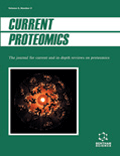
MOLECULAR & CELLULAR PROTEOMICS
Scope & Guideline
Exploring the intersection of biochemistry and analytical chemistry.
Introduction
Aims and Scopes
- Proteomic Methodologies:
The journal publishes research on advanced proteomic techniques, including mass spectrometry, phosphoproteomics, and glycoproteomics, which are essential for the detailed analysis of protein structures, functions, and interactions. - Clinical Applications of Proteomics:
A significant focus is placed on the clinical implications of proteomic findings, particularly in cancer research, where proteomic profiles can inform prognosis and treatment strategies. - Integrative Multi-Omics Approaches:
The integration of proteomics with genomics, transcriptomics, and metabolomics is a core area, facilitating comprehensive insights into biological systems and disease states. - Biomarker Discovery and Validation:
Molecular & Cellular Proteomics serves as a platform for discovering and validating biomarkers for various diseases, enhancing the potential for precision medicine. - Technological Innovations:
Papers often highlight novel tools and methodologies that push the boundaries of traditional proteomics, including single-cell proteomics, spatial proteomics, and advanced bioinformatics solutions.
Trending and Emerging
- Immunopeptidomics:
The field of immunopeptidomics is gaining traction, focusing on the identification and characterization of peptide-MHC interactions, which are critical for understanding immune responses and developing immunotherapies. - Single-Cell Proteomics:
There is an increasing emphasis on single-cell proteomics, allowing for the exploration of cellular heterogeneity and the identification of unique protein signatures at the individual cell level. - Post-Translational Modifications (PTMs):
Research on PTMs, particularly glycosylation and phosphorylation, is trending, as these modifications play crucial roles in protein function and regulation, influencing various biological processes and disease mechanisms. - Proteogenomics:
The integration of proteomics with genomics (proteogenomics) is emerging as a powerful approach for uncovering novel protein-coding genes and understanding the complexities of gene expression and regulation. - Microbiome and Host Interactions:
Studies exploring the proteomic aspects of microbiome-host interactions are on the rise, reflecting a growing interest in how these interactions influence health and disease.
Declining or Waning
- Basic Proteomics Techniques:
There appears to be a waning interest in basic proteomics techniques that do not incorporate advanced methodologies or multi-omics integrations, as the field increasingly values comprehensive and innovative approaches. - Research on Classical Cell Signaling Pathways:
Studies focusing solely on classical signaling pathways without integration with proteomic data have diminished, reflecting a move towards more complex analyses that consider multiple signaling networks and their interactions. - Descriptive Proteomics Studies:
There has been a reduction in purely descriptive studies that do not provide functional insights or clinical relevance, as the field shifts towards more impactful research that addresses specific biological questions.
Similar Journals

Current Proteomics
Elevating Insights in Biochemistry and Molecular BiologyCurrent Proteomics is a distinguished journal dedicated to the dynamic field of proteomics, offering researchers and professionals a platform to disseminate innovative findings and comprehensive reviews. Published by Bentham Science Publishers Ltd, this journal caters to a global audience and serves as an essential resource for students, academics, and industry experts interested in advances in biochemistry and molecular biology. With an ISSN of 1570-1646 and an E-ISSN of 1875-6247, the journal has established itself in various research categories, achieving a Q4 ranking in both Biochemistry and Molecular Biology as of 2023. While the impact factor and H-index data are not specified, its Scopus ranking reflects a competitive position in its fields, with percentiles in the 12th to 16th range. Although not an open-access journal, Current Proteomics is vital for fostering ongoing dialogue and collaboration in proteomic research, encouraging contributions that explore cutting-edge methodologies and applications. Researchers are invited to share their insights and contribute to this evolving discipline, thus enhancing the collective understanding of proteomics within the scientific community.

Expert Review of Proteomics
Unveiling the Complexities of Proteomics Research.Expert Review of Proteomics, published by TAYLOR & FRANCIS LTD, is a distinguished journal that focuses on the latest advancements in the field of proteomics, a critical area within biochemistry and molecular biology. With an ISSN of 1478-9450 and E-ISSN 1744-8387, this journal has been pivotal in disseminating high-quality research from its inception in 2004 to its planned convergence in 2024. Its influential position is reflected in its 2023 rankings, placing it in the Q2 category for both Biochemistry and Molecular Biology, alongside respectable Scopus rankings that rank it 118th and 141st in its respective categories. Despite its non-open access structure, Expert Review of Proteomics provides researchers and professionals with a vital platform for critical reviews and insights into proteomic methodologies, thus contributing significantly to the global scientific community. By bridging theoretical research with practical applications, it serves as an essential resource for those dedicated to advancing their knowledge and expertise in this dynamic field.

Cancer Genomics & Proteomics
Fostering collaboration for breakthroughs in cancer research.Cancer Genomics & Proteomics is a pivotal journal published by the International Institute of Anticancer Research, dedicated to advancing the fields of cancer genomics and proteomics. Established in 2004 and running until 2024, this journal provides a vital platform for the dissemination of high-quality research that explores genetic and protein interactions in cancer, thereby fostering innovations in diagnostics and therapeutics. The journal boasts a commendable Q2 ranking in Biochemistry and Genetics and is recognized in the Q3 tier for its contributions to Cancer Research and Molecular Biology, reflecting its growing impact in these dynamic fields. Operating out of Greece, it engages a diverse audience, including researchers, clinicians, and students, by sharing significant findings and methodological advancements in the realm of cancer studies. While currently not an open-access publication, Cancer Genomics & Proteomics remains committed to enriching scientific dialogue and collaboration with its insightful articles and reviews.

Proteome Science
Innovating Biological Insights Through ProteomicsProteome Science is an esteemed academic journal specializing in the field of proteomics, providing a platform for advanced research and discussions surrounding the structure, function, and dynamics of proteins in biological systems. Published by BMC, a reputable publisher recognized for its commitment to open-access publishing, Proteome Science has been disseminating pivotal research findings since its inception in 2003. Targeted towards researchers, professionals, and students in biochemistry and molecular biology, the journal aims to foster collaboration and innovation within the scientific community. While it currently holds a Q3 quartile ranking in both Biochemistry and Molecular Biology categories, its impactful contributions to the field are reflected in its accessibility, as evidenced by its open access policy. By embracing collaborative research methodologies and providing a platform for novel findings, Proteome Science plays a crucial role in advancing the understanding of proteomic analyses, catering to a global audience that values groundbreaking scientific discovery.

Frontiers in Molecular Biosciences
Advancing Knowledge in Molecular BiosciencesFrontiers in Molecular Biosciences is an esteemed open-access journal published by FRONTIERS MEDIA SA, based in Switzerland. Since its inception in 2014, the journal has made significant strides in the fields of biochemistry, genetics, and molecular biology, cementing its reputation with a solid position in the Q1 quartile for both Biochemistry and Genetics and Molecular Biology (miscellaneous) categories as of 2023. With a remarkable Scopus rank of #14/103 in the combined categories, it offers an essential platform for the dissemination of high-quality research that shapes the understanding of molecular processes and their implications in health and disease. The journal’s commitment to open access facilitates the broadest possible reach for groundbreaking discoveries, serving as a vital resource for researchers, professionals, and students alike. Located at AVENUE DU TRIBUNAL FEDERAL 34, LAUSANNE, this journal continues to foster innovative discussions and advancements in molecular biosciences, paving the way for new insights and collaborations in the scientific community.

PROTEIN JOURNAL
Connecting Researchers to Protein BreakthroughsProtein Journal, published by Springer, stands as a significant academic resource in the fields of Analytical Chemistry, Biochemistry, Bioengineering, and Organic Chemistry. Since its inception in 1996, the journal has dedicated itself to the dissemination of high-quality research focused on protein chemistry and its biomedical applications. With an impressive impact reflected in its classification as a Q2 journal in Analytical Chemistry and Q3 in both Biochemistry and Bioengineering as of 2023, it provides an essential platform for researchers and practitioners to share their findings. The journal embraces the open-access model, enhancing accessibility to cutting-edge research. The Protein Journal is crucial for academicians, industry professionals, and students, catering to their need for rigorous scientific discourse and innovative discoveries in protein studies. With an established track record of converging over two decades of knowledge and research, it continues to influence and shape the advancements in this vital area of science.

PROTEOMICS
Unraveling the complexities of biological systems.PROTEOMICS is a leading journal focused on the rapidly evolving field of proteomics, published by WILEY in Germany. With a solid reputation established since its inception in 2001, it has continually contributed to the understanding of protein functions and interactions within biological systems. As part of its commitment to academic excellence, PROTEOMICS is ranked in the second quartile for both Biochemistry and Molecular Biology categories (2023), reflecting its significant influence in advancing research in these areas. Although it does not currently provide open access options, it remains a vital resource for researchers, professionals, and students keen to explore innovative methodologies and findings in proteomic research. By publishing groundbreaking studies that bridge theoretical knowledge with practical applications, PROTEOMICS plays a crucial role in enhancing our understanding of molecular processes and driving forward advancements in the life sciences.

Comparative Biochemistry and Physiology D-Genomics & Proteomics
Transforming Knowledge: The Essential Journal for Genomic and Proteomic AdvancesComparative Biochemistry and Physiology D-Genomics & Proteomics, published by Elsevier Science Inc, is a premier journal in the realm of molecular biology and comparative physiology, with a focus on genomic and proteomic sciences. Recognized for its high-impact contributions, it holds a Q1 ranking in Animal Science and Zoology and was established with the vision of bridging gaps in our understanding of biological systems through experimental and comparative approaches. With an impressive Scopus ranking, this journal not only ranks among the top 12% in Animal Science and Zoology but also demonstrates commendable standings across various categories including Aquatic Science and Molecular Biology. The journal’s commitment to disseminating high-quality research makes it an essential resource for researchers, professionals, and students alike, allowing them to access critical studies that influence advancements in genomics and proteomics. While it operates under a traditional subscription model, its impactful findings are crucial for those aiming to enrich their knowledge and research capabilities in these pivotal scientific fields. Join us in exploring the transformative insights and developments that this esteemed journal has to offer for the study of genomics and proteomics.

Biomarker Research
Catalyzing collaboration in the world of biomarker research.Biomarker Research is a leading open access journal published by BMC, dedicated to advancing the field of biomarker discovery and clinical application. Since its inception in 2013, this journal has become a crucial resource for researchers and professionals in biochemistry, clinical biochemistry, and molecular medicine, achieving a prestigious Q1 ranking in each category in 2023. With an E-ISSN of 2050-7771, it maintains a strong reputation for disseminating high-quality research and innovative findings that contribute to the understanding of disease mechanisms and the development of novel diagnostics and therapeutics. The journal is accessible to a global audience, ensuring that vital research is freely available to promote collaboration and accelerate scientific progress. Operating out of the United Kingdom, Biomarker Research plays a significant role in addressing some of the most pressing challenges in medical research, making it an essential resource for academics, clinicians, and industry professionals alike.

Proteomes
Unlocking the Secrets of Protein Structures and Functions.Proteomes, published by MDPI since 2013, is a notable open access journal that occupies a critical place in the realms of Biochemistry, Clinical Biochemistry, Molecular Biology, and Structural Biology. Based in Switzerland, this journal not only promotes the dissemination of high-quality research pertaining to protein structures and functions but also emphasizes interdisciplinary approaches that bridge various fields of biomedical science. With a Category Quartile ranking of Q2 across multiple pertinent categories in 2023, Proteomes boasts a competitive impact within the scientific community, evidenced by its robust Scopus rankings. Researchers, professionals, and students are invited to explore a wealth of pioneering studies and reviews that are made freely accessible, aligning with global trends in open scientific communication. Whether contributing original research or seeking to expand their knowledge, the journal serves as an invaluable resource for anyone engaged in the evolving landscape of proteomics.